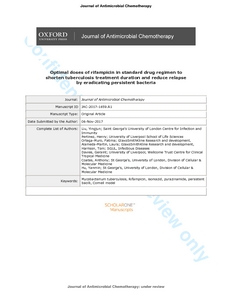Liu, Y; Pertinez, H; Ortega-Muro, F; Alameda-Martin, L; Harrison, T; Davies, G; Coates, A; Hu, Y
(2018)
Optimal doses of rifampicin in the standard drug regimen to shorten tuberculosis treatment duration and reduce relapse by eradicating persistent bacteria.
J Antimicrob Chemother, 73 (3).
pp. 724-731.
ISSN 1460-2091
https://doi.org/10.1093/jac/dkx467
SGUL Authors: Coates, Anthony Robert Milnes Hu, Yanmin
![[img]](https://openaccess.sgul.ac.uk/109574/7.hassmallThumbnailVersion/Revised%20version%20Sub%20061117.pdf)  Preview |
|
PDF
Accepted Version
Available under License ["licenses_description_publisher" not defined].
Download (617kB)
| Preview
|
Abstract
Objectives: Although high-dose rifampicin holds promise for improving tuberculosis disease control by eradication of persistent bacteria, the optimal dose of rifampicin that kills persistent bacteria and shortens the treatment duration is unknown. Methods: The Cornell mouse model was used to test the efficacy of rifampicin at elevated doses combined with isoniazid and pyrazinamide to kill actively growing and persistent bacilli and to measure relapse rate. Persistent bacteria were evaluated using Mycobacterium tuberculosis culture supernatant containing resuscitation-promoting factors. Pharmacokinetic parameters and dose-dependent activity for cultivable and persistent bacilli were determined. Results: Increasing doses of rifampicin in combination with isoniazid and pyrazinamide resulted in dose-dependent faster bacterial clearance. Evaluated both on solid media and in culture filtrate containing resuscitation-promoting factors, a regimen containing a standard dose of rifampicin at 10 mg/kg over 14 weeks failed to achieve organ sterility. In contrast, higher doses of rifampicin achieved organ sterility in a much shorter time of 8-11 weeks. Disease relapse, which occurred in 86% of mice treated with the standard regimen for 14 weeks, was completely prevented by rifampicin doses of ≥ 30 mg/kg. Conclusions: In the treatment of murine tuberculosis, a rifampicin dose of 30 mg/kg was sufficient to eradicate persistent M. tuberculosis, allowing shorter treatment duration without disease relapse.
| Item Type: |
Article
|
| Additional Information: |
This is a pre-copyedited, author-produced version of an article accepted for publication in Journal of Antimicrobial Chemotherapy following peer review. The version of record Yingjun Liu, Henry Pertinez, Fatima Ortega-Muro, Laura Alameda-Martin, Thomas Harrison, Geraint Davies, Anthony Coates, Yanmin Hu; Optimal doses of rifampicin in the standard drug regimen to shorten tuberculosis treatment duration and reduce relapse by eradicating persistent bacteria, Journal of Antimicrobial Chemotherapy, Volume 73, Issue 3, 1 March 2018, Pages 724–731 is available online at: https://doi.org/10.1093/jac/dkx467 |
| Keywords: |
Microbiology, 1115 Pharmacology And Pharmaceutical Sciences, 0605 Microbiology, 1108 Medical Microbiology |
| SGUL Research Institute / Research Centre: |
Academic Structure > Infection and Immunity Research Institute (INII) |
| Journal or Publication Title: |
J Antimicrob Chemother |
| ISSN: |
1460-2091 |
| Language: |
eng |
| Publisher License: |
Publisher's own licence |
| Projects: |
|
| PubMed ID: |
29244108 |
| Dates: |
| Date |
Event |
| 2018-03 |
Published |
| 2017-12-12 |
Published Online |
| 2017-11-08 |
Accepted |
|
 |
Go to PubMed abstract |
| URI: |
https://openaccess.sgul.ac.uk/id/eprint/109574 |
| Publisher's version: |
https://doi.org/10.1093/jac/dkx467 |
Statistics
Item downloaded times since 27 Feb 2018.
Actions (login required)
 |
Edit Item |



